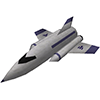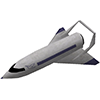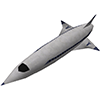Executive SpaceWays
Executive SpaceWays is a passenger transport company based on Lavebe in Galaxy Four. Founded by notable minerals magnate Gide van Heysel, Executive has built a strong reputation both for its flight services and its spacecraft designs, and counts many politicians, celebrities and business leaders amongst its clients.
Contents
Beginnings
Executive SpaceWays has its origins in the early days of Gide van Heysel's professional career. As an apprentice engineer, van Heysel was often required to travel to far-flung mining outposts for which passenger services were extremely limited, frequently operating obsolescent craft with questionable safety records. While tourists and celebrities enjoyed the comforts of the latest high-speed starliners, the millions of workers employed by the mining industry were forced to endure month-long journeys in slow and uncomfortable transport vessels.
Years later, having made billions with his metallurgical research company, GvH Engineering, van Heysel finally took the opportunity to redress the balance and commissioned a local design bureau, OKB Korshkov, to construct a high speed passenger transport for use by his employees and clients. After a lengthy evaluation period involving numerous different prototypes, the design known as H-4 was selected for production. Upon its official launch, at GvH's headquarters on Lavebe, the craft was officially named by van Heysel as the Trident Executive Shuttle.
Passenger Services
By the time of the Trident's launch, the project had gathered considerable public interest and van Heysel had begun to recognise the potential in offering reliable transport services to the wider business community. A subsidiary company, Executive SpaceWays, was created to manage flight operations and soon the Trident was seeing service in many of the Galaxy's more stable systems.
The Trident services proved to be a massive success, and with prospects riding high the company re-invested a large proportion of its profits into another development, a proposed long-range cruise liner. However, Executive was dealt a terrible blow when a Trident was destroyed in a suspected pirate attack near the People’s Republic of Raceedat. To quell public concern over passenger security, van Heysel immediately instructed his engineering department (which had since taken over from Korskhov as the ship’s primary manufacturer) to develop an escort fighter which could protect future flights from similar attacks.
The Gemini Programme
Under great pressure, Executive’s engineers re-used elements of the Trident design to construct a small two-man fighter which could be pushed into production as quickly as possible. Lacking any detailed knowledge of weapon design, the company could only equip the fighter with a commercially-available beam laser, although space was found for four missile pylons. To make up for the shortfalls in the spaceframe design, the set of navigational avionics found on the Trident was replaced by a set of more combat-orientated systems, while Gide van Heysel launched a recruitment drive to attract former Navy pilots with combat experience. Against the odds, the Gemini Programme (so-called because of its two-man crew) was a success, and once Executive had recovered its own financial position, the E-3 Gemini Escort was marketed to other spacelines as an effective escort ship in its own right.
Delta and Strelka
Executive’s engineers were never totally happy with the Gemini, particularly its short range as it prevented it from escorting long-haul flights. An improvement programme was duly undertaken, resulting in the release of the E-5 Delta Long-Range Escort. Along with the Gemini, the Delta soon became an escort of choice for many spacelines and traders.
With the Delta in service, the opportunity arose for Executive to return to its postponed cruise liner programme. Despite the luxury enjoyed by Trident passengers, on longer routes the need for multiple stopovers was found to incur frequent delays and increasingly-exorbitant docking charges. The only alternative for long-haul flights, given the 7 light-year witchjump barrier, was to refuel at each system en route by sunskimming, only making port at the flight’s final destination. Although a popular technique for pilots of smaller ships, sunskimming was rarely used as a refuelling method by larger transports due to the control instability experienced within a star’s corona. The challenge for Executive’s engineers was to build a ship that could harness the resources of the stars without affecting the level of comfort experienced by passengers.
In partnership with OKB Korshkov, Executive developed an integrated fuel scoop and engine assembly to allow sunskimming to be carried out at the utmost efficiency: on many ships, the installation of scoops involves additional pipework that can be as little as 40% efficient. Heat shielding was applied to the underside of the ship, and in addition a plasma field generator, developed from shield booster technology, was installed to prevent the magnetic field in the corona from interfering with the ship’s systems. In a further drive for efficiency, the flow of charged particles through the scoop was used to generate on-board electrical power through magnetohydrodynamic induction. The efficiency of the engine and fuel scoop delivered by these methods meant that sunskimming could be achieved in the higher levels of the coronal atmosphere, reducing the risk of damage to the ship and further cutting down on flight times. It also meant that in terms of fuel and energy, the ship was virtually self-sufficient and could travel non-stop to the most distant locations in the galaxy.
The ship, officially named as the H-7 Strelka CruiseLiner, now acts as the flagship of the Executive SpaceWays line, and can be encountered in high-tech stable systems accompanied by a group of Delta Escorts.
StarSeeker
In the wake of the success of the Strelka, Executive's latest model, the P-3 StarSeeker, was developed specifically to tap into the growing private transport market. While passenger cabin conversion kits had long been available from most major shipyards, the level of comfort offered by such producs varied wildly and compatibility issues often arose when attemping to fit the cabins in non-standard spacecraft. Using experience gained from work on the Gemini and the Trident, Executive SpaceWays sought to develop a small craft optimised for passenger transport, with all the necessary life support and intercom systems fitted as standard. Although more expensive than a typical transport, the StarSeeker comes with guaranteed engineering standards and is a popular choice for VIPs and small courier firms.
Ship List
 Delta Long-Range Escort |
 Gemini Escort |
 Starseeker Personal Shuttle |
 Strelka Cruise Liner |
 Trident Executive Shuttle |
A full-colour brochure is available from the company's offices on New Tsiolkovsky, or can be downloaded as an electronic PDF.
External Links
Download v2.4.4 in OXZ format here for Oolite 1.79 or later (downloaded 0 times).
Download v2.4.3 in OXZ format here for Oolite 1.79 or later (downloaded 327 times).
Download v2.4.2 in OXZ format here for Oolite 1.79 or later (downloaded 855 times).
Previous v.2.4 is here (downloaded 3273 times).